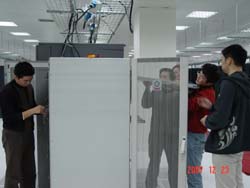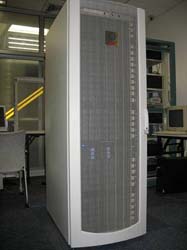

On 26 December, 2007, the KD-50-I, the first computer capable of teraflop speeds based on the Loongson (formerly named Godson) processor series and other China-made components, equipment and technologies passed the accreditation by a panel of experts led by Prof. WANG Shoujue, a renowned expert on information science and a CAS Member. Made by a team at the University of Science and Technology of China (USTC), the feat marks a further breakthrough in the development of advanced computers in China.
It has been typical for domestically built teraflop systems to adopt central processing chips provided by western IT giants like IBM, Intel or AMD. The KD-50-I, however, bases its outstanding performance on domestically developed technologies, in particular the Loongson 2F, a Pentium IV equivalent devised by the CAS Institute of Computing Technology (ICT) in 2007. To construct an affordable and powerful scientific computing platform open to the public, the USTC team headed by CAS Member Prof. CHEN Guoliang at the Department of Computer Science initiated a cooperative program with the ICT and started to install the "KD-50-I" in May 2007, employing the Loongson 2F as its crucial part.
Integrating over 330 units of Loongson 2F installed in 1U12P architecture of high computing density, the supercomputer achieves a performance of 1.0 TFlop/s. Applying open source software as its operating system, it features good compatibility as well as easy maintenance, upgrading and use.
The new system is also highlighted by its energy-efficiency and low costs. Equivalent to a 1.5GHz Intel Pentium IV in performance, the Loongson 2F consumes only one tenth of the energy its Intel counterpart devours. As a result, the whole KD-50-I system runs at a power of only 6 kwh. At a cost of no more than 800,000 yuan, it is believed that this high performance computer will find its applications in teaching and research of high performance computing and training of talents; it will also see promising prospects in R&D activities in a wide spectrum of disciplines of natural sciences and the economic development of this country, meeting the ever-increasing demands of high performance computing for massive sets of data.
Apart from computing capacity, it has been the ICT's main goal to decrease the energy consumption and cost of its processors, since its first success of the series, the Godson 1. This strategy is aimed to making Loongson-based computers affordable for most Chinese people. As a result from the business strategy taken by leading CPU producers to maximize the commercial profit through continuously upgrading the CPU clock speeds, 90% of people in this country can not afford a computer.
As small as a household fridge, the KD-50-I confirms the central role played by China-made high-performance general processors in the application of high-end dual core systems in this country. It is expected that a Loongson-based supercomputer with a performance of 100 TFlop/s will be installed in the year of 2008, refreshing expectations about the potential of this processor series.








